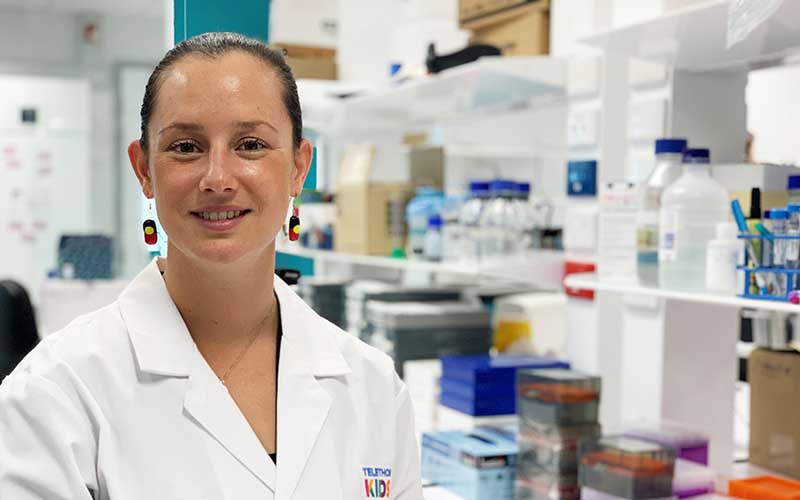Search
Research
Whole genome, transcriptome and methylome profiling enhances actionable target discovery in high-risk pediatric cancerThe Zero Childhood Cancer Program is a precision medicine program to benefit children with poor-outcome, rare, relapsed or refractory cancer. Using tumor and germline whole genome sequencing (WGS) and RNA sequencing (RNAseq) across 252 tumors from high-risk pediatric patients with cancer, we identified 968 reportable molecular aberrations.
Research
A surveillance clinic for children and adolescents with, or at risk of, hereditary cancer predisposition syndromesHereditary cancer predisposition syndromes (HCPS) account for at least 10% of paediatric cancers.1 Li‐Fraumeni syndrome (LFS) is a dominant HCPS caused by mutations in the TP53 gene and is associated with an 80–90% lifetime risk of cancer, commencing in infancy.2 Children of affected individuals are at 50% risk of inheriting the family mutation.
Research
Impact of early childhood infection on child development and school performance: a population-based studyChildhood infection might be associated with adverse child development and neurocognitive outcomes, but the results have been inconsistent.
Research
Financial incentives to motivate treatment for hepatitis C with direct acting antivirals among Australian adultsUntreated hepatitis C virus (HCV) infection can result in cirrhosis and hepatocellular cancer. Direct-acting antiviral (DAA) therapies are highly effective and have few side effects compared to older interferon-based therapy. Despite the Australian government providing subsidised and unrestricted access to DAA therapy for chronic HCV infection, uptake has not been sufficient to meet the global target of eliminating HCV as a public health threat by 2030.
Research
Edaravone for the Treatment of Motor Neurone Disease: A Critical Review of Approved and Alternative Formulations against a Proposed Quality Target Product ProfileEdaravone is one of two main drugs for treating motor neurone disease (MND). This review proposes a specific quality target product profile (QTPP) for edaravone following an appraisal of the issues accounting for the poor clinical uptake of the approved IV and oral liquid edaravone formulations. This is followed by a review of the alternative oral formulations of edaravone described in the published patent and journal literature against the QTPP.
Research
Influenza vaccination in Western Australian children: Exploring the health benefits and cost savings of increased vaccine coverage in childrenTo assess potential benefits and direct healthcare cost savings with expansion of an existing childhood influenza immunisation program, we developed a dynamic transmission model for the state of Western Australia, evaluating increasing coverage in children < 5 years and routinely immunising school-aged children.
Research
Development of a sustained release implant of benzathine penicillin G for secondary prophylaxis of rheumatic heart diseaseRegular intramuscular (i.m.) benzathine penicillin G (BPG) injections have been the cornerstone of rheumatic heart disease (RHD) secondary prophylaxis since the 1950s. Patient adherence to IM BPG is poor, largely due to pain, the need for regular injections every 3-4 weeks and health sector delivery challenges in resource-limited settings. There is an urgent need for new approaches for secondary prophylaxis, such as an implant which could provide sustained penicillin concentrations for more than 6 months.
Research
The role of children in transmission of SARS-CoV-2 variants of concern within households: an updated systematic review and meta-analysis, as at 30 June 2022Meta-analyses and single-site studies have established that children are less infectious than adults within a household when positive for ancestral SARS-CoV-2. In addition, children appear less susceptible to infection when exposed to ancestral SARS-CoV-2 within a household. The emergence of SARS-CoV-2 variants of concern (VOC) has been associated with an increased number of paediatric infections worldwide.

News & Events
The Kids Research Institute Australia Cancer Researcher recognised in 2021 Business Events Perth Aspire AwardsOne of The Kids Research Institute Australia’s leading young researchers will travel to the world’s premier conference on childhood brain cancer.
Research
Roadmap to incorporating group A Streptococcus molecular point-of-care testing for remote Australia: a key activity to eliminate rheumatic heart diseaseJonathan Asha Dylan Rosemary Janessa Jeffrey Carapetis AM Bowen Barth Wyber Pickering Cannon AM MBBS FRACP FAFPHM PhD FAHMS BA MBBS DCH FRACP PhD
Research
Correlates of immunity to Group A Streptococcus: a pathway to vaccine developmentUnderstanding immunity in humans to Group A Streptococcus (Strep A) is critical for the development of successful vaccines to prevent the morbidity and mortality attributed to Strep A infections. Despite decades of effort, no licensed vaccine against Strep A exists and immune correlates of protection are lacking; a major impediment to vaccine development.
Research
Diabetic Ketoacidosis at Onset of Type 1 Diabetes and Long-term HbA1c in 7,961 Children and Young Adults in the Australasian Diabetes Data NetworkThe relationship between diabetic ketoacidosis (DKA) at diagnosis of type 1 diabetes and long-term glycemic control varies between studies. We aimed, firstly, to characterize the association of DKA and its severity with long-term HbA1c in a large contemporary cohort, and secondly, to identify other independent determinants of long-term HbA1c.
Research
Influenza epidemiology in patients admitted to sentinel Australian hospitals in 2019: the Influenza Complications Alert Network (FluCAN)This report summarises the epidemiology of hospitalisations with laboratory-confirmed influenza during the 2019 influenza season. The Influenza Complications Alert Network (FluCAN) is a sentinel hospital-based surveillance program that operates at sites in all jurisdictions in Australia.
